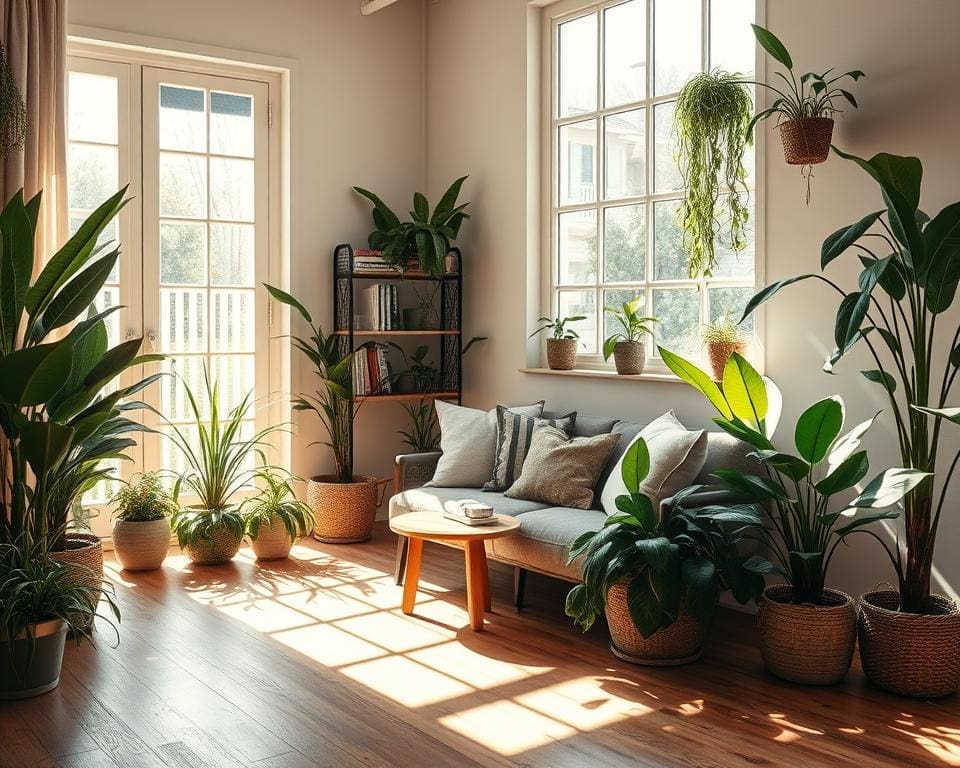In the quest for a tranquil and inviting home environment, understanding how to pick the best indoor plants for your space is essential. These remarkable greenery companions not only enhance the aesthetic appeal of a room but also provide numerous benefits, such as improving air quality and uplifting mood. Research highlights the positive psychological effects of indoor plants, making them perfect allies in indoor gardening.
Before diving into choosing indoor plants, it’s important to assess your unique indoor environment and personal preferences. Whether you long for vibrant foliage or low-maintenance options, this guide will equip you with the insights needed to select the best indoor plants that resonate with your lifestyle and space.
Understanding Your Indoor Environment
Creating a thriving indoor garden starts with an intimate comprehension of your unique surroundings. Understanding your indoor environment encompasses various factors, including light availability, humidity levels, and the space available for plant growth. Each element plays a pivotal role in ensuring the health and vitality of your plants.
Assessing Light Conditions
One of the fundamental aspects of understanding your indoor environment is assessing light conditions. Consider the type of natural light each room receives—whether it is direct, indirect, or low light. Plants vary in their light requirements, so identifying these conditions helps select suitable varieties that will flourish in your space.
Evaluating Humidity Levels
Another critical factor is evaluating humidity levels. Most houseplants thrive in environments with moderate to high humidity. To ensure a suitable atmosphere, you might find hygrometers helpful in monitoring moisture levels within your home. Low humidity can lead to wilting and poor growth, making this an essential consideration.
Recognising Space Restrictions
Finally, recognising space restrictions is vital for successful plant selection. An awareness of plant size and growth habits prevents overcrowding as they mature. Taking the time to measure your available space allows for a harmonious arrangement, ensuring each plant can develop properly without competing for resources.

How to Pick the Best Indoor Plants for Your Space
Choosing the right indoor plants can significantly enhance your living environment. The journey begins with understanding what you truly desire from your plants, which involves identifying your preferences and taking into account the maintenance requirements of your selected choices.
Identifying Your Preferences
The aesthetics of your indoor plants play a pivotal role in creating a pleasing atmosphere. Consider whether you prefer lush foliage and vibrant colours or a more minimalist look that features subtle greens. Think about how the colour schemes of your chosen plants will blend with your existing decor. Identifying your preferences will lead you towards the best indoor plants that not only suit your taste but also elevate your space.
Considering Maintenance Requirements
Each plant comes with its own set of care needs, so understanding maintenance requirements is essential. Some varieties, such as succulents, require minimal attention, making them ideal for busy lifestyles. Others may need regular watering, pruning, and a more attentive approach. As you embark on selecting indoor plants, take time to research the specific care levels needed for each, ensuring they align with your availability and commitment.
Exploring Popular Indoor Plants
Finding the right indoor plants can greatly enhance your living space, bringing life and colour into your home. Each category of plants offers benefits tailored to different environments. Discover a range of options that fit your specific needs, from low-light areas to humid conditions, ensuring your indoor foliage selection creates a tranquil atmosphere.
Top Low-Light Houseplants
Many people face the challenge of finding suitable greenery for areas with minimal light. Fortunately, several popular indoor plants excel in low-light conditions. Among the top low-light houseplants, the snake plant stands out for its resilience and striking vertical leaves. Pothos is another great choice, with its trailing vines and ability to thrive in shade. These plants not only brighten dim rooms but also work hard to purify the air.
Best Indoor Plants for Humid Spaces
For those living in environments with higher humidity levels, selecting the best indoor plants for humid spaces becomes essential. Peace lilies are wonderful, as they adore moisture and can bloom beautiful white flowers, adding elegance to any setting. Ferns also flourish in such conditions, offering lush foliage that brings a touch of the tropics indoors. Such plants effortlessly adapt to warm and humid environments, making them ideal companions for your home.
Vibrant Indoor Foliage Selection
Adding vibrancy to your interior is easy with the right indoor foliage selection. Monstera is a showstopper with its large, distinctive leaves that can transform any room’s aesthetic. The rubber plant also stands tall with its glossy leaves and varied colours, ideal for those wanting a healthy mix of texture and style. Selecting such vibrant plants can elevate your decor, turning your space into a green paradise.
Tips for Choosing Indoor Plants
When it comes to selecting indoor plants, it’s essential to consider how these green companions can enhance your living space. One of the crucial tips for choosing indoor plants is to focus on pairing plants with your decor. This involves assessing the colours, shapes, and sizes of your furniture and choosing plants that will complement rather than compete with your current aesthetic. For example, a sleek, modern sofa may pair wonderfully with minimalist succulents, while a vintage armchair could be beautifully offset by lush ferns.
Another key aspect to remember is using plant height and growth patterns to create visual interest in your interiors. Arrange taller plants towards the back of your display or room, allowing shorter ones to take centre stage. This layering approach adds depth and can make your space feel more dynamic. Consider popular varieties like the snake plant for height, while keeping delicate peace lilies in the front for their stunning white blooms.
Finally, mastering the art of combining different indoor plants is crucial for achieving a harmonious arrangement. It’s helpful to understand each plant’s needs, ensuring that those with similar light and moisture requirements are grouped together. For instance, combining pothos and philodendron can create an inviting jungle vibe while ensuring both flourish under the same conditions. By following these inspirational tips, you can create a vibrant and cohesive indoor garden that reflects your unique style.









